

Global Property Guide. Data traveler ultimate. Global burden of disease as a result of indoor air pollution in Shaanxi, Hubei and Zhejiang, China - 1-s2.0-S004896971100057X-main.pdf. ScienceDirect.com - Science of The Total Environment - Global burden of disease as a result of indoor air pollution in Shaanxi, Hubei and Zhejiang, China. The World Factbook. ShowIntroduction :: CHINA Panel - Collapsed For centuries China stood as a leading civilization, outpacing the rest of the world in the arts and sciences, but in the 19th and early 20th centuries, the country was beset by civil unrest, major famines, military defeats, and foreign occupation.
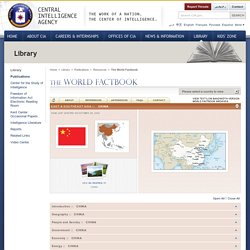
After World War II, the Communist Party of China under MAO Zedong established an autocratic socialist system that, while ensuring China's sovereignty, imposed strict controls over everyday life and cost the lives of tens of millions of people. After 1978, MAO's successor DENG Xiaoping and other leaders focused on market-oriented economic development and by 2000 output had quadrupled. For much of the population, living standards have improved dramatically but political controls remain tight. Since the early 1990s, China has increased its global outreach and participation in international organizations.
Owner-occupier. An owner-occupier (also known as an owner-occupant or home owner ) is a person who lives in and owns the same home .

It is a type of housing tenure . The home of the owner-occupier may be, for example, a house , apartment , condominium , or a housing cooperative . National Bureau of Statistics of China. Sales Prices of Residential Buildings in 70 Medium and Large-sized Cities in April 2013. I.

The Sales Prices of Newly Constructed Residential Buildings (excluding affordable housing) Comparing with the previous month, among 70 medium and large-sized cities, the sales prices of newly constructed residential buildings declined in 2 cities while that of 1 city remained at the same level. For 67 cities with increasing prices month-on-month, the biggest increase was 2.1 percent. Comparing with the same month of last year, the sales prices of newly constructed residential buildings decreased in 2 cities. For 68 cities with increasing prices year-on-year, the biggest increase was 13.7 percent, and the increase of 1 city fell down compared with that in March 2012. II. Sales Price Indices of Residential Buildings in 70 Large and Medium-Sized Cities (2013.04) Price Indices of Second-Hand Residential Buildings by Floor Space in 70 Large and Medium-Sized Cities (2013.04)
Price Indices of Newly Constructed Residential Buildings by Floor Space in 70 Large and Medium-Sized Cities (2013.04) China's housing market: Is there a bubble about to burst? Cost of Living in China. Prices in China. Effect of central ventilation and air conditioner system on the concentration and health risk from airborne polycyclic aromatic hydrocarbons. Urbanization process and induced environmentalgeological hazards in China. ScienceDirect.com - Energy and Buildings - Some significant environmental issues in high-rise residential building design in urban areas. Estimating the impact of the home appliances trade-in policy on WEEE management in China. ScienceDirect.com - Resources, Conservation and Recycling - Predicting future quantities of obsolete household appliances in Nanjing by a stock-based model.
ScienceDirect.com - Energy Policy - Chinese consumer attitudes towards energy saving: The case of household electrical appliances in Chongqing. PAH pollution during Haze in China (stats on PAH negative health effects) STEP CHANGE: design of urban residence in Hangzhou. Housing in China. Here’s What A Chinese Real Estate Expert Says About Whether There’s A Bubble Forming Or Not. Here’s the worst-case scenario: China’s housing market tanks, which sends the country’s financial system into free-fall, taking the global economy down with it.
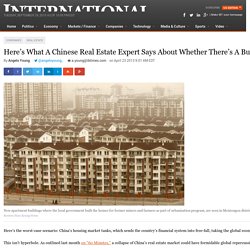
The result? You lose your job and end up eating only beans and rice as you slog through the next global economic recession. This isn’t hyperbole. As outlined last month on “60 Minutes,” a collapse of China’s real estate market could have formidable global repercussions. If China falls, so could the U.S., in part because the Chinese would have to curb their purchasing of U.S. This is why all eyes are on Chinese real estate, which makes up about a fourth of the world’s fastest-growing economy. So what’s going on besides the fact that the Chinese seem to want to live in cities?
Dillon offered up the two sides of the coin to the Shanghaiist blog on Tuesday. Reason to be worried: because the Chinese government is worried. Headlines like “Shanghai New Home Prices up 273% in 7 years” make a strong case for the existence of a bubble. China's housing market: Is there a bubble about to burst? China Home Prices Threaten Stability. Chinese property bubble (2005–2011) The 2005–2011 Chinese property bubble was a real estate bubble in residential and/or commercial real estate in the People's Republic of China .
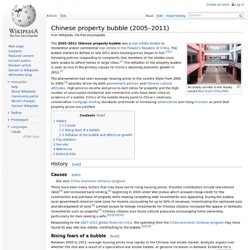
The bubble started to deflate in late 2011 when housing prices began to fall, [ 1 ] [ 2 ] following policies responding to complaints that members of the middle-class were unable to afford homes in large cities. [ 2 ] The deflation of the property bubble is seen as one of the primary causes for China's declining economic growth in 2012. [ 2 ] The phenomenon had seen average housing prices in the country triple from 2005 to 2009, [ 3 ] possibly driven by both government policies and Chinese cultural attitudes . High price-to-income and price-to-rent ratios for property and the high number of unoccupied residential and commercial units have been cited as evidence of a bubble. History [ edit ] Causes [ edit ] There have been many factors that may have led to rising housing prices. [PDF] Urban Housing Markets in China. [PDF] Estimating the Willingness-to-Pay for Urban Housing in Chinese Cities. Chinese Homes. Chinese homes fascinate me.
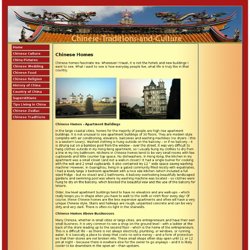
Whenever I travel, it is not the hotels and new buildings I want to see. What I want to see is how everyday people live, what life is truly like in that country. Chinese Homes - Apartment Buildings In the large coastal cities, homes for the majority of people are high rise apartment buildings. It is not unusual to see apartment buildings of 30 floors. Older, low level apartment buildings tend to have no elevators and are walk-ups – which really keeps you in shape when you have to walk to the sixth or ninth floor every day! Chinese Homes Above Businesses Many Chinese, whether in small cities or large cities, are entrepreneurs and have their own small business.
Interiors. Chinese kitchens are different from Western kitchens. Often kitchens were not included in house plans. For richer families, cooking was done in the servants' quarters. House Architecture. Homes all over China in pre-modern times had a lot in common. The way of laying out a house was similar among the rich and poor, both in earlier and later times. Certain materials and techniques, such as pounded earth foundations, timber framing, and use of bricks and tile were present throughout the country.
Nevertheless, houses were by no means identical in all parts of China. If we look at houses in different regions we can see much that differed from place to place. Although few examples of Chinese homes have survived from antiquity, using archeological evidence, scholars have determined that many of the basic principles of Chinese house design, such as the emphasis on orientation, layout, and symmetry go far back in Chinese history. Chinese architecture. Diagram of corbel wood bracket supports (" Dougong ") holding up a multi-inclined roof, from the architectural treatise Yingzao Fashi (1103 AD) Chinese architecture refers to a style of architecture that has taken shape in East Asia over many centuries.
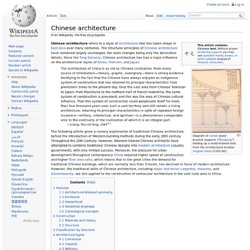
The structural principles of Chinese architecture have remained largely unchanged, the main changes being only the decorative details. Since the Tang Dynasty , Chinese architecture has had a major influence on the architectural styles of Korea , Vietnam , and Japan . The architecture of China is as old as Chinese civilization. From every source of information—literary, graphic, exemplary—there is strong evidence testifying to the fact that the Chinese have always enjoyed an indigenous system of construction that has retained its principal characteristics from prehistoric times to the present day. Features [ edit ] The rectangular compound shown above has two sections of courtyards. Architectural bilateral symmetry [ edit ] Chinese urbanization and urban housing growthsince the mid-1990s. IKEA with Chinese Characteristics. The Swedish furniture retail giant is bringing its unique style—and sales model—to China by Paula M.
Miller For a truly global experience, try stepping off the streets of Shanghai into one of IKEA’s largest outlets. Though the first item you see may have been made in China, it was more likely made in Vietnam, or if it is a piece of furniture, in Europe. IKEA Group, a franchisee of Inter IKEA Systems BV, entered China in 1998 when it opened its first store in Shanghai. IKEA’s mainland China stores belong to the IKEA Group and operate as joint ventures. (IKEA Hong Kong and IKEA Taiwan are separate franchisees.)
A new, redesigned Shanghai store opened in 2003, replacing the original outlet. IKEA opened its first Beijing store in early 1999. Important to this physical expansion, of course, is revenue expansion. In fiscal year 2003, PRC factories produced nearly a quarter of IKEA’s goods; the company aims to produce more than a third of its goods locally in the next four years. Satisfaction with the Standard of Living in Reform-Era China. Articles Satisfaction with the Standard of Living in Reform-Era China * Chunping Han The University of Texas at Arlington.

Email: hancp@uta.edu. A comparative study of location-sharing privacy preferencesin the United States and China. Chinese glocalization – a study of intergenerational residence in urban China. Access to Housing in Urban China - LOGAN - 2009 - International Journal of Urban and Regional Research - Wiley Online Library.